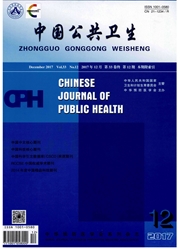

 中文摘要:
中文摘要:
目的构建中国疟疾风险评估指标体系,为我国疟疾风险预警工作提供参考依据。方法通过文献研究初步确定疟疾风险评估指标体系,抽取24名从事相关领域的专家参与第1轮指标的筛选,采用熵值法对咨询结果进行优化。结果专家对所有指标熟悉程度的得分均〉7分,权威系数均〉8分,专家咨询的协调系数为0.212(X^2=121.876,P〈0.01);经过熵值法优化调整后疟疾病例数、居民夏季室外暴露时间、疫区流人人员数量和政府疟疾风险关注度指标权重上调幅度较大,权重依次为0.1751、0.1410、0.1006、0.1037,最终得到一套涵盖2个一级指标、8个二级指标、26个三级指标的疟疾风险评估指标体系。结论采用德尔菲法与熵值法相结合进行疟疾风险评估具有一定优势;此评估指标体系评估内容较为全面系统,与实际工作中疟疾风险的发生紧密相关,能较为有效的评估某一地区的疟疾风险。
 英文摘要:
英文摘要:
Objective To establish an index system for effective assessment of malaria risk in China and to provide references for early warning of malaria risk in China. Methods The index system of malaria risk assessment was estab-lished primarily based on literature research; then an initial screening on indicators of the system was conducted by 24 experts and the expert consultation results were optimized with entropy method. Results The scores of familiarity with all the indexes for the experts were greater than 7 ; the authority coefficients were greater than 8 ; and the coordination coefficient for the expert consultation was 0. 212 (X^2 = 121. 876, P 〈 0. 01 ). After adjustment with entropy optimization, the weight of number of malaria incidents, exposure time of the residents in summer season, number of persons entering an endemic region, and governmental attention for malaria risk were markedly upregulated, with the values of 0. 175 1, 0. 141 0,0. 100 6, and 0. 103 7, respectively. The index system established finally includes 2 first-tier indicators, 8 secondtier indicators, and 26 third-tier indicators. Conclusion Delphi method combined with entropy method is of advantages when used in malaria risk assessment. The established index system is comprehensive,systematic ,and more closely related to the occurrence of malaria risk in real situation and could be used for effective assessment of malaria risk.
 同期刊论文项目
同期刊论文项目
 同项目期刊论文
同项目期刊论文
 期刊信息
期刊信息
